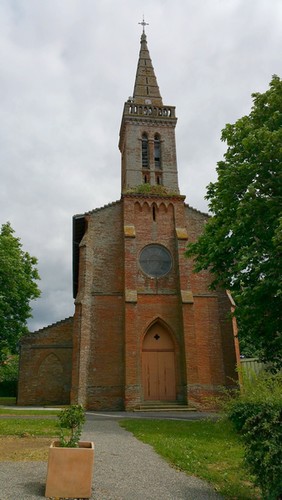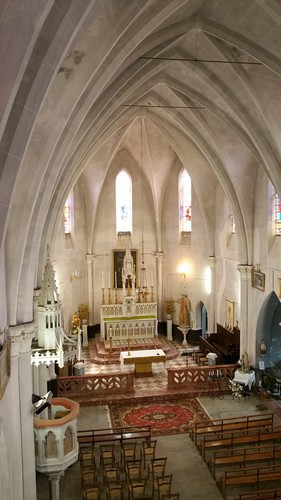EGLISE SAINT LOUP DE BONREPOS-RIQUET
 Until the French Revolution, the parishioners of Bonrepos went to the church of Saint-Jean-de-Mongague in the north-east of the village, at the current location of the water tower. The building, which had survived the events of the Wars of Religion (fires by the Huguenots in 1570 and 1593), had to be abandoned at the beginning of the 19th century for lack of maintenance. One of the barns of the castle was then used, transformed into a religious space for the occasion and dedicated to Saint Loup, patron saint of the old chapel of the castle destroyed in the 18th century.
Until the French Revolution, the parishioners of Bonrepos went to the church of Saint-Jean-de-Mongague in the north-east of the village, at the current location of the water tower. The building, which had survived the events of the Wars of Religion (fires by the Huguenots in 1570 and 1593), had to be abandoned at the beginning of the 19th century for lack of maintenance. One of the barns of the castle was then used, transformed into a religious space for the occasion and dedicated to Saint Loup, patron saint of the old chapel of the castle destroyed in the 18th century.In 1891, a new church again dedicated to Saint Loup was built on a plot of 450 m2, valued at 270 francs of the time (about 1100 € today) during the inventory carried out by the State on March 5, 1906 following the law of December 9, 1905 relating to the separation of Church and State. Construction expenses amounted to 26,151.25 francs (approximately €106,173). .
The first parish priest who officiated in this new place of worship was Ambroise Jean Pierre Lajous, born in Toulouse on May 6, 1868. Still according to the law of December 9 he was granted by the State an ecclesiastical allowance until the end of 1913.
Built at the end of the 19th century, the architecture of the church is inspired by Gothic art. It is implanted so that the choir is to the east and the porch to the west (principle of the orientation of the light, therefore of the sun, as a symbol of Christ). The building is built entirely of brick. Its porch is surmounted by a spire bell tower containing two bells.
 Entering to the left of the main entrance is a red marble font surmounted by the statue of Saint Joseph, and on the right a small chapel with the baptismal font in white marble and a Virgin with the bird (representation of the Virgin quite rare).
Entering to the left of the main entrance is a red marble font surmounted by the statue of Saint Joseph, and on the right a small chapel with the baptismal font in white marble and a Virgin with the bird (representation of the Virgin quite rare).Before this chapel under the statue of Saint Germaine de Pibrac is a shrine containing a relic of the saint.
The nave has a length of about 14 meters. On the left side is the white marble pulpit with Gothic art sculpture.
The choir, paved with pink and white marble, is separated from the nave by a balustrade (the holy table) in red marble most likely from the quarries of Caunes Minervois in the Aude, exploited since Antiquity and still in activity.
The high altar is, like the pulpit, in Gothic style in white marble. It is topped with a ciborium.
On the right in the choir, we can see a gilded wooden statue of the 18th century probably representing Saint Lawrence first deacon of Pope Sixtus II.
The stained-glass window at sunrise depicts Christ the Savior of the world, holding the world in his left hand and blessing it with his right hand. On each side there are six stained glass windows representing the 12 apostles. At sunset the rose window represents Saint Loup as a bishop. They were created and realized in the Toulouse workshop under the direction and signature of Louis Victor Gesta, painter-glassmaker from Toulouse (1828 – 1894). Each stained-glass window is a private donation, at the bottom of which, one can read the names of the donors. You have entering a frame with some details about them.
Every August 15 for the Assumption, during a mass preceded by a procession in the park of the castle, a blessing is given to families under the patronage of Our Lady of the Children, whose statue is on the right near the chapel containing the statue of the Sacred Heart of Jesus. On the left pillar you can see a statuette representing the Infant Jesus of Prague (The history of this statuette deserves to be known).
The chapel on the left is dedicated to the Virgin Mary with a beautiful statue of the Virgin and an icon of Our Lady of Perpetual Help very interesting for its representation of the "presentiment of the Passion of Christ".At the entrance on the right near the bust of the Holy Curé of Ars is a relic of Saint Rose of Lima. On the outer wall the statue representing Our Lady of Lourdes comes from the castle acquired in December 2007 by the town hall of Bonrepos-Riquet.
Autres statues
Icône


